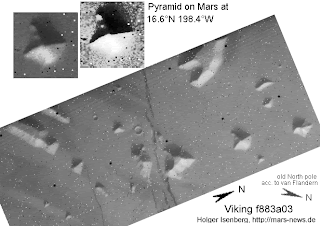In cleared-away areas of the upper Amazon basin, researchers, using satellite imagery, have recently pinpointed a vast network of monumental earthworks, including geometrically aligned roads and structures,constructed by a hitherto unknown civilization.
 According to a new report published in the journal Antiquity, the archeologist Martii Pärssinen and other scientists have documented more than two hundred and ten geometric structures, some of which may date as far back as the third century A.D. They are spread out over an area that spans more than two hundred and fifty kilometers, reaching all the way from northern Bolivia to the state of Amazonia in Brazil....
According to a new report published in the journal Antiquity, the archeologist Martii Pärssinen and other scientists have documented more than two hundred and ten geometric structures, some of which may date as far back as the third century A.D. They are spread out over an area that spans more than two hundred and fifty kilometers, reaching all the way from northern Bolivia to the state of Amazonia in Brazil.... Over the past several years, however, there has been mounting evidence that nearly everything that was once generally believed about the Amazon and its people was wrong, and that Fawcett was in fact prescient.
Over the past several years, however, there has been mounting evidence that nearly everything that was once generally believed about the Amazon and its people was wrong, and that Fawcett was in fact prescient. None of this wondrous discovery would have come as a shock to various authors who decades ago recorded the stories of the natives and explorers. During that time, however, mainstream archaeologists have frequently pooh-poohed these tales and ignored the whole astounding field. As we can see, times are changing. Perhaps these ruins could be the works of the Lamanites or the Nephites or even the people of Zarahemla in ancient America.
None of this wondrous discovery would have come as a shock to various authors who decades ago recorded the stories of the natives and explorers. During that time, however, mainstream archaeologists have frequently pooh-poohed these tales and ignored the whole astounding field. As we can see, times are changing. Perhaps these ruins could be the works of the Lamanites or the Nephites or even the people of Zarahemla in ancient America. This is a fascinating find has come from the tragic loss of Brazilian rainforest, making some lemonade out of that lemon. Of course, what this discovery of a long lost Amazonian civilization means is that there have been other times when the forest was likewise not there, giving us hope that currently devastated areas can be re-grown as well.
This is a fascinating find has come from the tragic loss of Brazilian rainforest, making some lemonade out of that lemon. Of course, what this discovery of a long lost Amazonian civilization means is that there have been other times when the forest was likewise not there, giving us hope that currently devastated areas can be re-grown as well. What this find also means is that those intrepid explorers of earlier times, such as Colonel P.H. Fawcett and many others, were correct in believing the natives, whose stories beginning centuries ago described not just one but many civilizations or cities lost in the massive rainforest as well as elsewhere in remote, overgrown parts of South America.
What this find also means is that those intrepid explorers of earlier times, such as Colonel P.H. Fawcett and many others, were correct in believing the natives, whose stories beginning centuries ago described not just one but many civilizations or cities lost in the massive rainforest as well as elsewhere in remote, overgrown parts of South America. As a result of the deforestation of the Amazon basin, a startling discovery has been made. Hidden from view for centuries, the vast archaeological remains of an unknown, ancient civilization have been found.
As a result of the deforestation of the Amazon basin, a startling discovery has been made. Hidden from view for centuries, the vast archaeological remains of an unknown, ancient civilization have been found. A study published in Antiquity, a British archaeological journal, details how satellite imagery was used to discern the footprint of the buildings and roads of a settlement, located in what is now Brazil and believed to span a region of more than 150 miles across....
A study published in Antiquity, a British archaeological journal, details how satellite imagery was used to discern the footprint of the buildings and roads of a settlement, located in what is now Brazil and believed to span a region of more than 150 miles across.... According to Martti Parssinen, Denise Schaan and Alceu Ranzi, the authors of the study, the community likely had a population of more than 60,000 people. The researchers said they have only uncovered roughly 10 percent of the existing structures, which may date as far back as A.D. 300....
According to Martti Parssinen, Denise Schaan and Alceu Ranzi, the authors of the study, the community likely had a population of more than 60,000 people. The researchers said they have only uncovered roughly 10 percent of the existing structures, which may date as far back as A.D. 300.... The brings to life British explorer Percy Harrison Fawcett claimed he had found evidence of an ancient civilization, which he called the City of Z, in the same area. He disappeared in the jungle on a 1925 expedition undertakenwith his son and a companion...
The brings to life British explorer Percy Harrison Fawcett claimed he had found evidence of an ancient civilization, which he called the City of Z, in the same area. He disappeared in the jungle on a 1925 expedition undertakenwith his son and a companion...































